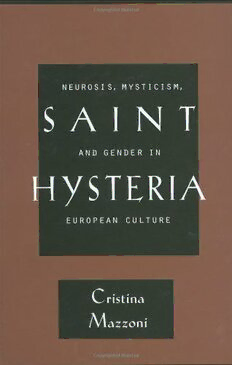
Saint Hysteria: Neurosis, Mysticism, and Gender in European Culture PDF
Preview Saint Hysteria: Neurosis, Mysticism, and Gender in European Culture
SAINT HYSTERIA 0 NEUROSIS, MYSTICISM, AND GENDER IN EUROPEAN CULTURE Cristina Mazzoni CORNELL UNIVERSITY PRESS ITHACA AND LONDON Copyright © 1996 by Cornell University All rights reserved. Except for brief quotations in a review, this book, or parts thereof, must not be reproduced in any form without permission in writing from the publisher. For information, address Cornell University Press, Sage House, 512 East State Street, Ithaca, New York 14850. First published 1996 by Cornell University Press Printed in the United States of America Library of Congress Cataloging-in-Publication Data Mazzoni, Cristina, 1965- Saint hysteria: neurosis, mysticism, and gender in European culture / Cristina Mazzoni. p. cm. Includes bibliographical references and index. ISBN 0-8014-3229-4 (alk. paper) 1. Women mystics—Europe—Psychology. 2. Christian women saints— Europe—Psychology. 3. Psychiatry and religion. 4. Hysteria. 5. Ecstasy. I. Title. BV5083.M325 1996 248.2'2'o82—dc20 96-13417 © The paper in this book meets the minimum requirements of the American National Standard for Information Sciences— Permanence of Paper for Printed Library Materials, ANSI Z39.48-1984. To My Family mamma, papa, Pietro, Sabrina, Silvia, Paola, Stefano John, Paul, and Gemma Contents Preface ix INTRODUCTION Historicizing Hysteria, Hysterizing History: A Dialogue of Neurosis and Religion i 1 The Ecstasy of Saint Hysteria: Women's Mysticism in Medical Writings 17 2 Mystical Languages of Illness: Naturalism in France and Italy 54 3 Decadence and Saintliness: Hagiographies or Pathographies? 90 4 Mystical Self-Interpretations: From the Age of Spirituality to the Age of Hysteria 156 viii 0 Contents CONCLUSION From Hysterical Anguish to Mystical Ecstasy: Old Symptoms of a New Sainthood 197 Bi bliography 213 Index 227 Preface As cultural productions such as the film Agnes of God attest, it is still today a cliche to represent mystical experiences as inherently neurotic. Levitation, mystical marriage, visions, and especially stigmata appear to us uncanny, too strange to fit within the bounds of what we embrace as healthy normality. Clearly, however, the identification of mysticism with hysteria was not always so prevalent, nor did it appear overnight. What impelled me to write this book is the question of how this in¬ tertwining took place, and why women were its target. Accordingly, I have examined scientific, literary, and religious texts, concentrating on the late nineteenth and early twentieth centuries, to discover how they converge in a fascination with the otherness of the female body while it is in (ecstatic) pleasure or in (neurotic) pain. Through this interdis¬ ciplinary reading, the dialogue between hysteria and its repressed other—mysticism—is discernible at various levels and in diverse discourses. As I discuss in the Introduction, the medical history of hys¬ teria has been continuously linked to the religious history of supernat¬ ural phenomena, and the medical discourse of positivism remains dependent on the religious-feminine element it attempts to repress. Similarly, a continuity may be detected between the literature of nat¬ uralism and that of decadence in their representation of the interde¬ pendence of neurosis and religion, a continuity that breaks down the presumed antinomy between these two literary currents. The religious writings of women mystics too and the discourses they have inspired x 0 Preface around them reveal a never-resolved tension between nature and su¬ pernature, body and soul (or psyche), which, not surprisingly, mirrors and complicates the very issues raised by the process of hysterical con¬ version as described by psychoanalysis. Was the saint hysterized, then, or was hysteria canonized instead? "Academic work is one of those fields containing a pearl so precious that it is worth while to sell all our possessions, keeping nothing for ourselves, in order to be able to acquire it," wrote Simone Weil. In the course of my academic career I have been blessed with many "pearls" who have greatly enriched my life, both intellectually and with their friendship. At the University of California, San Diego, Stephanie Jed and Jon Snyder first helped me find a way in the field of literary and cultural studies. At Yale, Peter Brooks and Paolo Valesio read and sup¬ ported this project from the beginning and guided me through the labyrinth of tum-of-the-century French and Italian culture with sug¬ gestions, references, discussions, and much encouragement. Jane Chance, Michael Holquist, Stephanie Jed, Paul Lachance, Valerie La- gorio, Robert Proctor, Lucia Re, Jennifer Wicke, and the anonymous readers of Cornell University Press have all graciously commented on the manuscript; the editors at Cornell have made it more elegant and legible. I have also been given useful bibliographical references by John Cirignano, Anthony Russell, and John Thompson. Throughout, I have been fortunate to receive the valuable help of librarians, especially at Connecticut College and at the University of Vermont. It is an understatement to say that the book would not have reached this stage had it not been for the continuous support of Bern- hard Kendler. Finally, I wish to thank warmly all the people in the Department of Romance Languages at the University of Vermont for their academic as well as personal support during my time here, and for their patience with a toddler running and babbling through our halls and offices. In particular, Yvan Bamps, Sue Breeyear, Patrizia Jamieson, Donna Kuizenga, Gretchen Van Slyke, and John Weiger have provided me with much-needed advice on the most diverse topics. To my husband, John Cirignano, I owe more than I can say. Through¬ out these years, he has been the source of encouragement, inspiration, support, faith, love, hope, and much more. Without his wonderful par¬ enting of our first child I never would have been able to finish this book; and without his presence in my life, writing a book would have been a dry and empty exercise. I am grateful to the University Press of Florida for permission to reprint portions of my essay "On the (Un)Representability of Woman's
